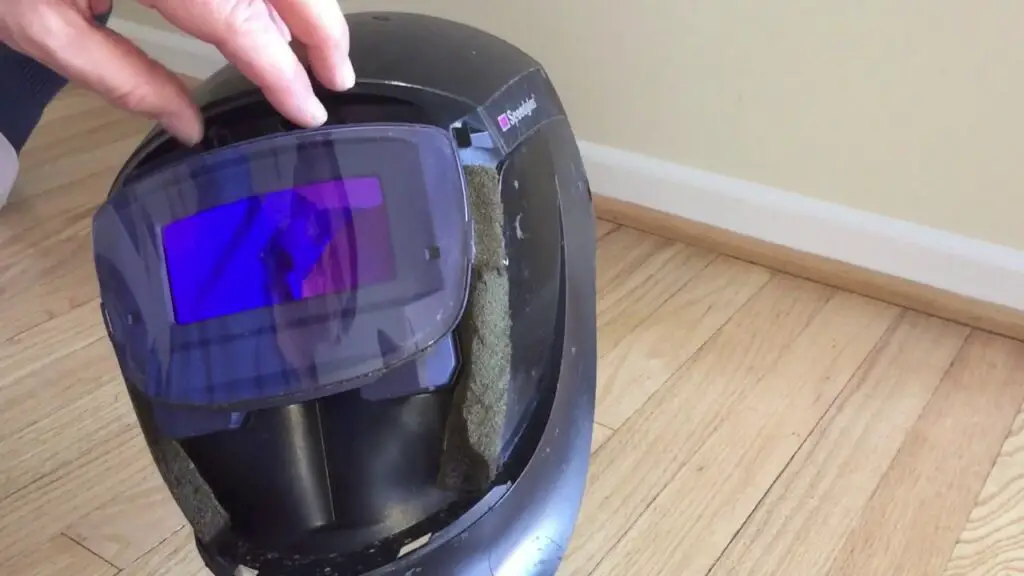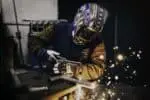Your welding helmet is an essential part of your welding PPE and keeping it in good condition not only has health benefits but is also economical.
A good quality welding helmet is comfortable and safe and you are less likely to suffer inconvenience when it comes to a good welding helmet.
A welding helmet will last long if there is proper maintenance like simply cleaning your welding helmet after use, storing it in a safe and clean area, and replacing the components as they wear out.
It is important to replace your welding helmet if they are damaged and can no longer serve the purpose of keeping you safe from welding hazards. Better quality helmets will often contain components that not only function better but also survive longer and are replaceable. 
Let us understand the different parts of a welding helmet and when it should be replaced.
1. Lens
Lenses are an important part of a welding helmet that only enables you to see properly but also safeguards your eyes from any harm.
Lenses are generally placed at the front of the helmet where they take a lot of sparks, heat and debris flying around. And that is why lenses are the most replaced item in a welding helmet.
But lenses too consist of two parts- front lens and inner lens. As the name suggests, the front cover lens lies in front of the auto-darkening filter, preventing weld spatter from entering and causing damage to the auto-darkening capability.
And depending on the welding methods and dirt levels, this will most likely need to be replaced on a frequent basis.
The inner cover lens shields the auto-darkening filter’s rear from dust and grime. When it starts to discolor and becomes difficult to clean, it should be changed.
When should you replace lens:
-
-
- If there are any visible blemishes or cracks.
- When it affects the vision.
- When the automatic darkening factor is not working properly.
-
2. Sweatbands
Because sweatbands prevent sweat from streaming down your face and distracting you during welding, they become quite a nuisance when they wear out. When this occurs, you must change the sweatband.
They usually go unnoticed until they become soiled or worn out.
When should you replace:
-
-
- When the sweatband becomes obviously worn or damaged.
- When they are too dirty to be used.
- The headgear no longer fits snugly.
-
3. Batteries for auto-darkening filters
Generally, auto-darkening welding helmets are solar powered as well as battery powered. And because most auto-darkening welding helmets are powered by batteries, you may need to replace them from time to time when they run out.
When should you replace:
-
-
- The battery indication shows that they must be replaced.
- The auto-darkening filter stops functioning properly.
-
4. Face seal
One of the most important components to keep harmful particles, dangerous gases and odors away from your face.
When should you replace:
-
-
- The battery indication shows that they should be replaced.
- If you notice any fumes while working, it’s time to replace the face seal.
- If any gas or fumes enter the helmet.
-
Lifespan of a welding helmet
The most crucial component of welding safety equipment is an auto-darkening welding helmet that ensures safety of your head and face.
But the issue is, what if your auto darkening lens isn’t operating properly?
You may feel eye fatigue or photokeratitis (also known as welders flash), which may cause harm to your eyes. That is why it is critical to ensure your auto darkening helmet is operational before you start with your welding work.
Some of the parts of your welding helmet need to be replaced on a regular basis, depending on how frequently you use the helmet, and it also depends on the environment, maintenance of the helmet.
Here we provide you with tips on how you can ensure longevity of your welding helmet.
Aside from repairing or replacing worn-out pieces, there are additional ways to keep your helmet in good working order for as long as possible.
1.) The first step is to always examine your auto-darkening helmet before and after usage.
2.) Dents, cracks, and other signs of damage should never be ignored.
3.) Do not place your helmet in an area where it is likely to fall and get damaged.
4.) You should know that the helmet’s lens is sensitive, therefore, keep it from being scraped or rubbing up against other objects.
5.) Before you utilise the item, look for any loose components or missing screws that need to be replaced.
6.) Another technique to extend the life of the helmet is to store it correctly.
7.) Store your helmet and other safety gear properly while not in use.
8.) Avoid getting your helmet wet, since moisture promotes the growth of germs.
Factors that affect longevity of welding helmets
The lifespan of your auto-darkening helmet is determined by a variety of things, including how well you care for it.
Most auto-darkening helmets, with good maintenance and care, should last you for at least seven years. This lifespan is affected mostly due to the sensors, lens (which can be changed in certain helmets), and battery.
It is crucial to remember that the principal causes of auto-darkening helmet failure are either the lens or the battery. These components are not removable in many low-cost helmets, so you’ll have to buy a new one.
1.) Longevity of Lens- The lens of your auto darkening welding helmet is the most susceptible portion and something that needs frequent replacement.
As a result, you should use it with great care. If you drop or misuse your helmet, you risk damaging the lens, which will have to be replaced.
2.) Battery Durability- The type, quality and brand of battery used by your auto-darkening helmet is another aspect that influences how long it will last. Usually, some batteries will require more frequent charging and replacement than others.
3.) Other miscellaneous factors influencing lifespan- Other important aspects that limit the longevity of your auto-darkening helmet are exposure to extreme cold temperatures and keeping it without power for extended periods of time.
And since cold temperatures affect the efficiency of the auto-darkening lens, it is advised that you do not store your helmet in a cold, dark place because the last thing you want to do is diminish the lifespan of the auto-darkening helmet’s lens while it’s in storage.
Conclusion
Testing your auto-darkening welding helmet before you start welding is an important safety precaution to minimise eye strain and harm.
Some helmets endure longer than others, thus they do not need to be replaced as frequently. Others, on the other hand, do not last as long and must be replaced on a regular basis.







